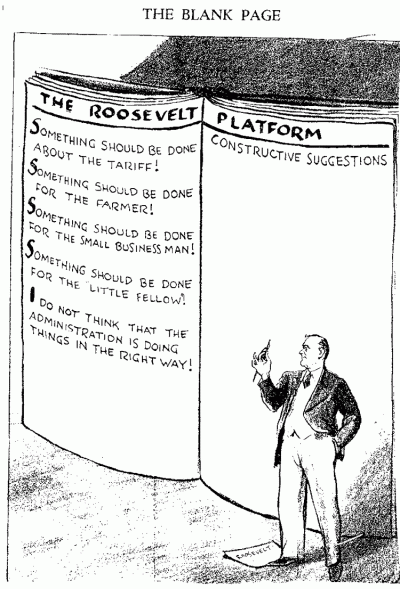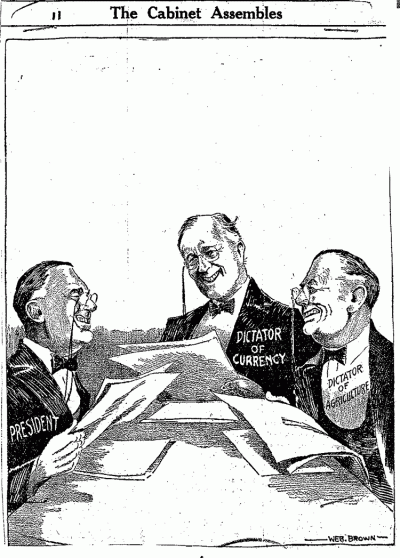During the 1932 campaign, Franklin Roosevelt had a reputation as a mealy-mouth politician who made many promises but held his real plans close to his chest. The following cartoons capture that well:
Of course, we now know that with his First Inaugural address (listen here), FDR took on the role of economic savior, with biblical language implicitly drawing a comparison to Jesus chasing lenders from the Temple (although Roosevelt carefully used the passive tense):
“The money changers have fled their high seats in the temple of our civilization. We may now restore that temple to the ancient truths.”
During his first 100 days, a supine Congress passed 15 major laws and effectively rubber-stamped whatever the White House sent to Capitol Hill. Subsequent presidents lived in the shadow of those “Hundred Days” as a test of a president’s ability to “get things done”–whether or not those things did any good.
On April 5th, one month into his presidency and in the midst of bank closures nationwide, Roosevelt ordered all Americans to stop “hoarding” (holding) any “gold coin, gold bullion or gold certificates.” Such “hoarding” did not “promote the public interest.” FDR achieved this feat by issuing Executive Order 6102 (“Requiring Gold Coin . . . to be Delivered to the Government”). Criminal penalty for violating the law: up to 10 years in prison! Note that an Executive Order doesn’t require any act of Congress. The president signs and orders something to be done, in this case the nationalization of all gold in the USA. Clinton aide Paul Begala captured the power of the executive order with the phrase:
“Stroke of the pen. Law of the land. Kind of cool.”
With Executive Order 6260 (“On Hoarding and Exporting Gold”), FDR drew upon the authority of the Trading with the Enemy Act (1917) as amended (1933). By declaring a “national emergency” equivalent to war, he became “dictator of currency” according to this cartoon:
How did the nation respond to nationalization of gold and the inflation of the money supply by nearly half? Scientific opinion polls did not exist but the media responded positively by showing FDR taking action, cutting the gold value of the dollar in half, thus lessening the farmers debt burden (the argument went) and kicking big bankers in the groin. Those themes are clear in these cartoons:
In January 1934, FDR took the final step by ordering all Federal Reserve Banks to hand over their gold. Actually, this time he asked Congress for the legislation to act. According to Roosevelt, complete nationalization of gold, coupled with a 41% devaluation of the dollar, meant a “fairer price level.” “Free circulation of gold coins is unnecessary,” FDR told Congress, and only necessary (and legal) for the “settlement of international balances” or between the “Nations of the world” (read: their governments). Adolf Hitler now had more right, under U.S. law, to obtain gold from the U.S. government than did the citizens of the United States! There was a fiscal point: to enhance “debt paying power” by paying back national (and private) debt with cheaper dollars. A power play: to declare it “the inherent right of Government to issue currency and to be the sole custodian and owners of [precious metals] underlying that currency.”
In short, a gold transaction between citizens or businesses was “not only unnecessary , but is in every way undesirable”! Besides, the private ownership of gold got in the way of devaluing the currency. No gold, no problem. Your debt is now cut by 41%. The media response to this final act was to link FDR with saving farmers from their debt:
It all sounded so easy. Too easy. Privately, one of FDR’s adviser’s, Bernard Baruch, warned that “Business moves on faith in promises, and money itself is a promise.” Publicly, John Maynard Keynes lambasted this “gold standard on the booze.” The Baltimore Sun noted the business uncertainty caused by this fiscal revolution (and who was to say there wouldn’t be more devaluation?):
“How much healthy, permanent business will be done if a man must plant his own or borrowed dollars today in the full knowledge that. . . Mr. Roosevelt, by a stroke of his pen, can cut in half the value of the dollars that he will collect three months hence or six months hence?”
Robert Higgs has shown how this “regime uncertainty” prolonged the Great Depression by undermining business confidence and dampening private investment. But what was bad for the economy was good for FDR; he simply substituted public spending for private investment, even though many economists (including Keynes) warned him that only the private sector could create a lasting recovery. Voters rewarded FDR at the polls, never seeing “what is not seen”: breaking windows (or money) is no way to “stimulate” the economy.
***
Further reading: Many business contracts contained “gold clauses” specifying payment in dollars worth a certain amount of gold. Most of those contracts were between companies but some were between contractors and the U.S. government. Could the government cut its real offering price in half after a company performed its end of the bargain? In the “Gold Clause Cases,” the Supreme Court ruled “yes.”
Amity Shlaes, The Forgotten Man (2008): Shlaes reports how FDR was planning to devalue the dollar even before taking office:
“One morning, FDR told his group [of advisers] he was thinking of raising the gold price by twenty-one cents. Why that figure? his entourage asked. ‘It’s a lucky number,’ Roosevelt said, ‘because it’s three times seven.’” As [Treasury Secretary] Morgenthau later wrote, ‘If anybody knew how we really set the gold price through a combination of lucky numbers, etc. I think they would be frightened.’”








